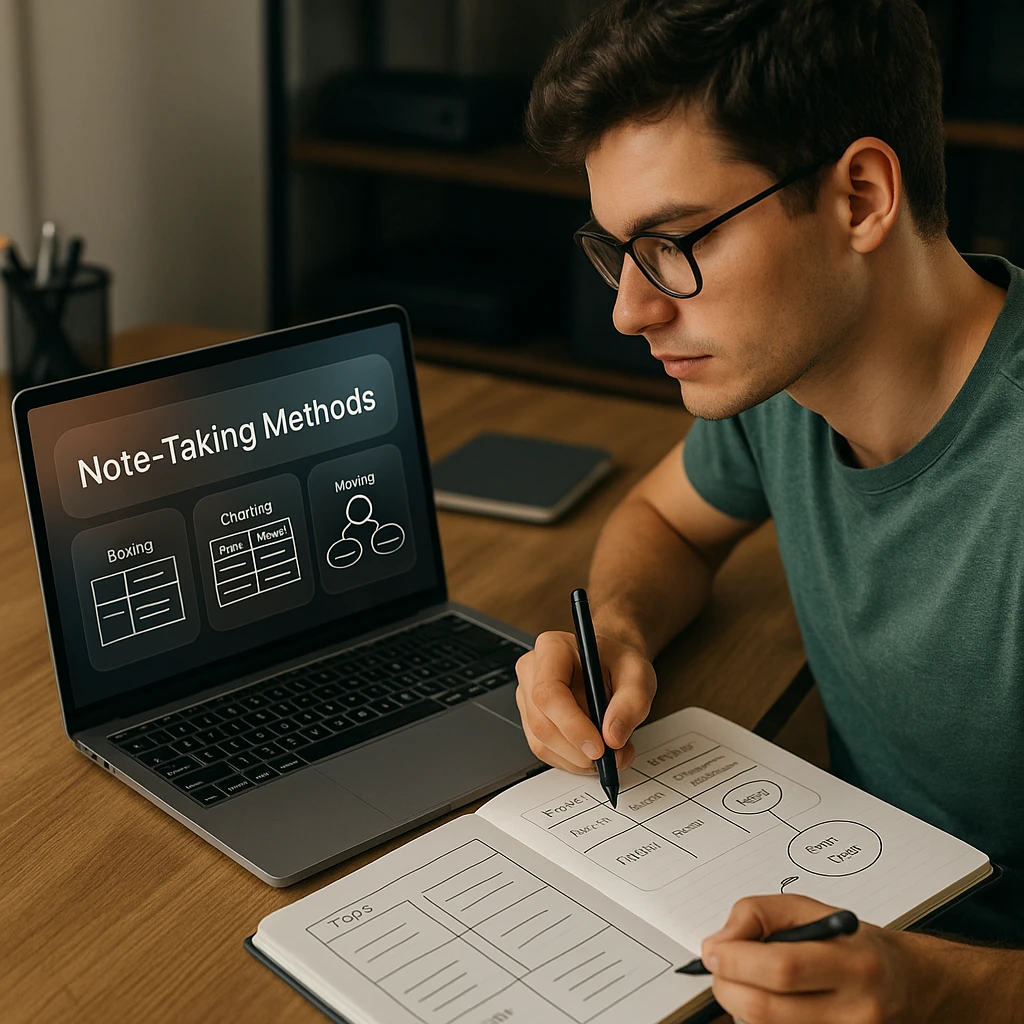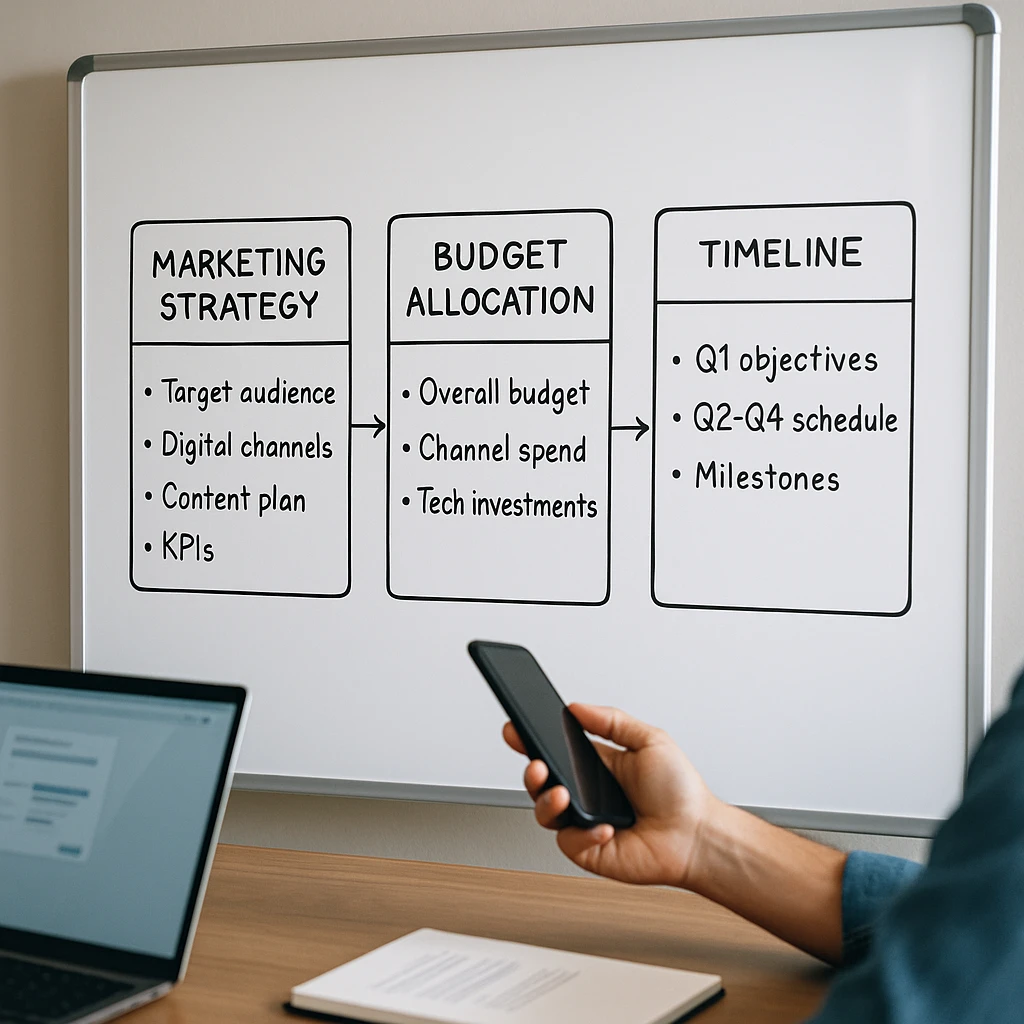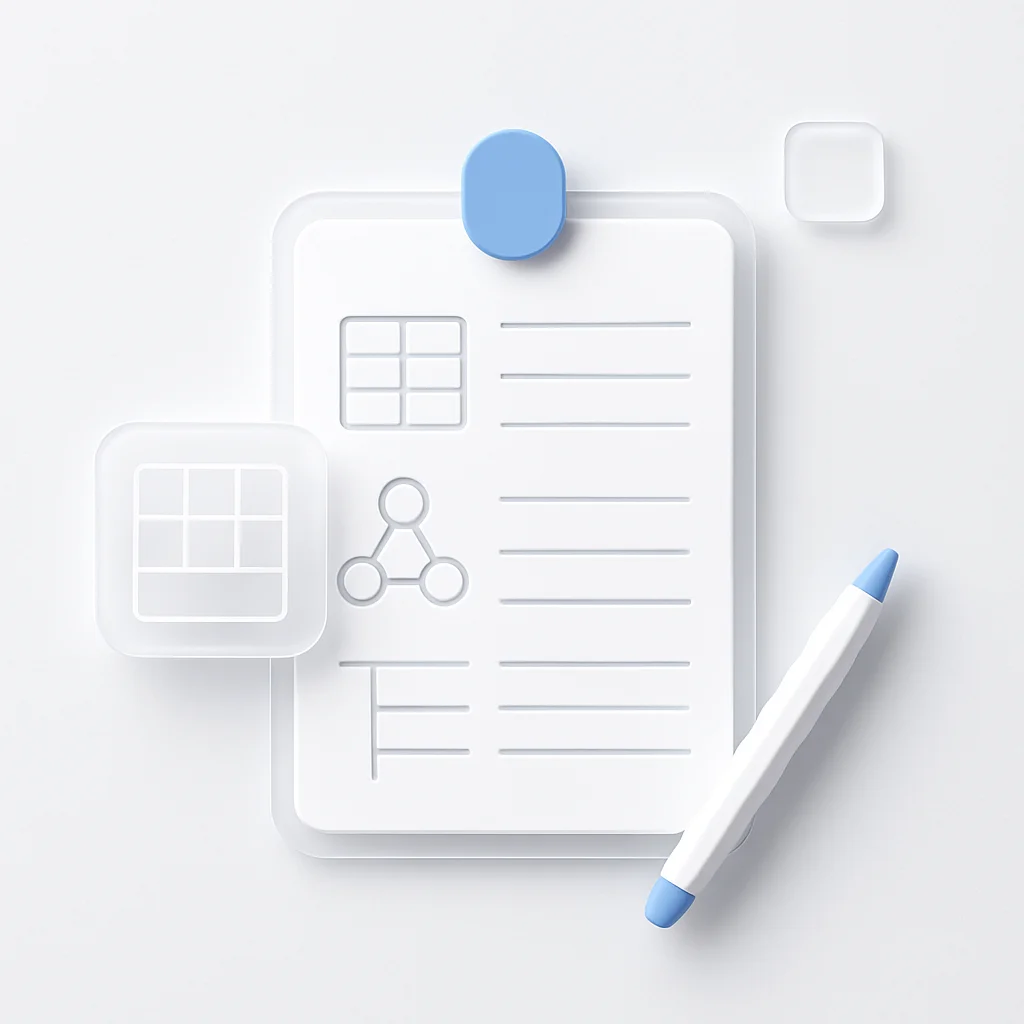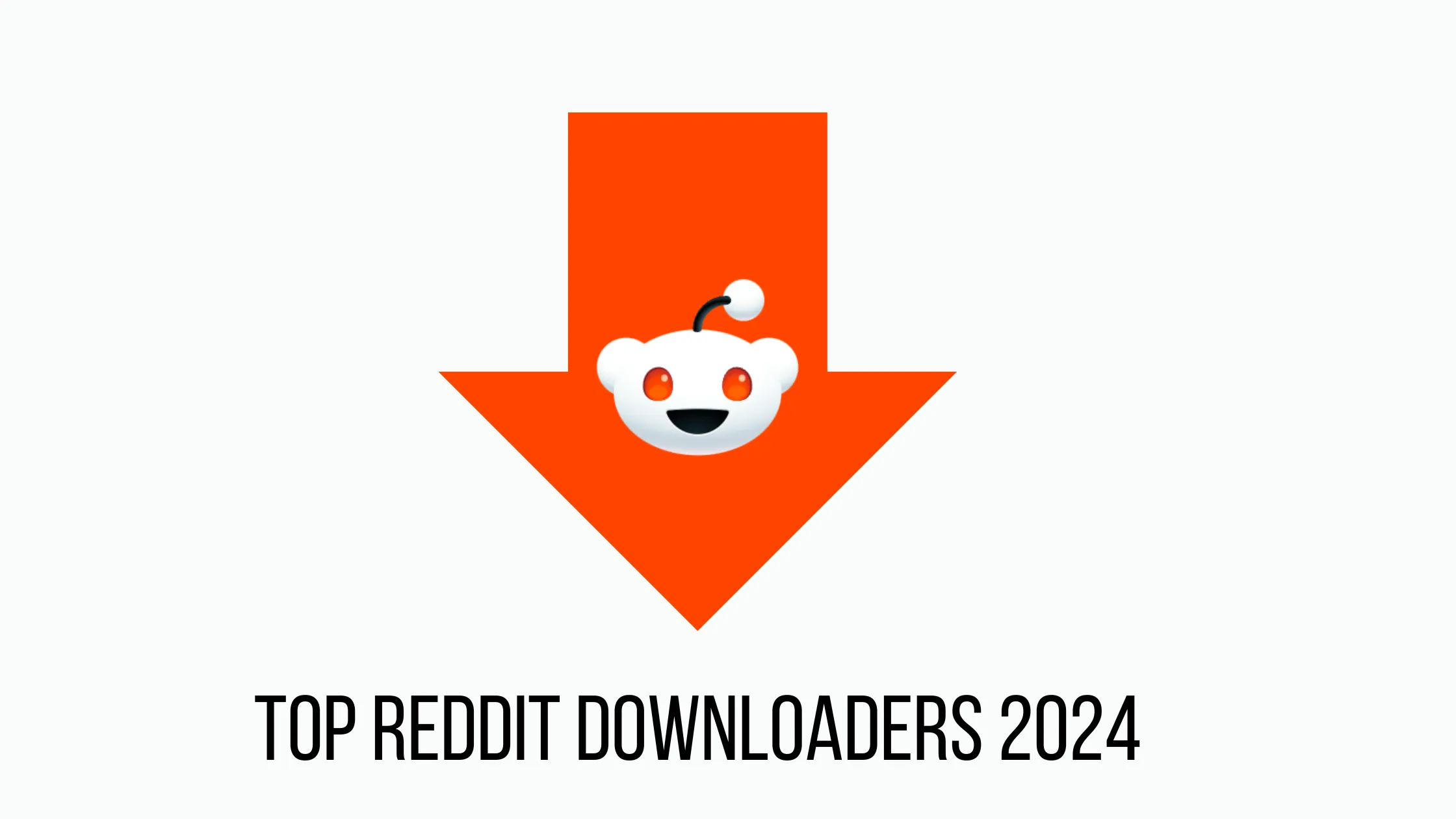Effective note taking methods can transform how you learn, retain information, and organize your thoughts. Whether you’re a student, professional, or lifelong learner, choosing the right technique makes the difference between scattered notes and a powerful learning system.
Here are the most proven note taking methods that work in 2025, including when to use each technique and practical examples you can start using today.

What Are Note Taking Methods?
Note taking methods are structured systems for capturing, organizing, and reviewing information. Different techniques work better for various situations - a history lecture needs a different approach than a business meeting or technical training.
The key is matching your note taking style to the content type, your learning preferences, and how you’ll use the information later.
The 5 Most Effective Note Taking Methods
1. Boxing Method Note Taking
Boxing method note taking organizes information into distinct boxes or sections, each containing related concepts. This visual separation makes complex topics easier to understand and review.
How It Works:
- Draw boxes around different topics or concepts
- Keep related information within each box
- Use different box sizes based on importance
- Connect related boxes with lines or arrows
Best For:
- Visual learners who need clear organization
- Complex subjects with multiple subtopics
- Brainstorming and idea organization
- Meeting notes with multiple agenda items
Example: For a marketing meeting, you might create separate boxes for “Marketing Strategy” (containing social media focus, target audience 25-45, Q3 campaign launch), “Budget Allocation” (40% digital ads, 30% content creation, 30% analytics tools), and “Timeline” (planning phase, execution milestones, review dates). Each box keeps related information contained while showing clear relationships between different aspects of the project.

2. Charting Method of Note Taking
The charting method of note taking uses tables and columns to organize information systematically. This structured approach works exceptionally well for comparing data, tracking progress, or organizing factual information.
How It Works:
- Create columns for different categories
- Fill in rows with specific information
- Use consistent formatting throughout
- Add headers for easy reference
Best For:
- Comparing multiple items or concepts
- Scientific data and research findings
- Historical timelines and events
- Business analysis and planning
Example:
| Method | Best Use | Pros | Cons |
|---|---|---|---|
| Boxing | Visual organization | Clear separation | Takes more space |
| Charting | Data comparison | Easy to scan | Limited flexibility |
| Mapping | Relationships | Shows connections | Can get messy |
3. Mapping Method of Note Taking
Mapping method of note taking creates visual connections between ideas using diagrams, mind maps, and flowcharts. This technique helps you see relationships and hierarchies that linear notes might miss.
How It Works:
- Start with a central topic in the middle
- Branch out with related subtopics
- Use lines, arrows, and shapes to show connections
- Add colors and symbols for different categories
Best For:
- Understanding complex relationships
- Creative problem-solving
- Planning projects with multiple components
- Subjects with interconnected concepts
Visual learners particularly benefit from mapping because it engages both logical and creative thinking processes.
4. Cornell Note Taking System
The Cornell method is a systematic approach that includes a summary section at the end. This method divides your page into three sections: notes, cues, and summary.
How It Works:
- Divide page into note-taking area (largest section)
- Create a cue column for keywords and questions
- Leave space at bottom for summary
- Review and fill in cues after the session
Best For:
- Academic lectures and seminars
- Professional development sessions
- Any situation requiring later review
- Building long-term knowledge retention
The Cornell system answers the question: “Which method of taking notes includes a summary at the end?” - making it perfect for comprehensive learning.
5. Flow Method Note Taking
Flow method note taking captures information as it naturally occurs, using arrows, bullet points, and indentation to show the logical progression of ideas.
How It Works:
- Write main topics on the left margin
- Indent subtopics and details
- Use arrows to show cause and effect
- Number items in sequence when needed
Best For:
- Lectures that jump between topics
- Process documentation
- Troubleshooting and problem-solving
- Creative brainstorming sessions

Choosing the Right Note Taking Style
For Visual Learners
Note taking for visual learners works best with spatial organization and visual elements. The boxing method creates clear visual boundaries that help your brain categorize information, while mapping methods use diagrams and connections to show relationships between concepts. Adding color coding for different categories and creating visual shortcuts with symbols makes your notes more memorable and easier to review.
Visual learners often struggle with traditional linear notes because their brains prefer spatial organization. If you’re studying from video content, the Video Ask AI feature can help you quickly find specific visual examples or diagrams within recorded lectures, making it easier to create comprehensive visual notes.
For Different Content Types
Which note-taking method is most useful to show how main ideas and details relate? The mapping method excels at showing relationships, while other methods work better for different purposes. Scientific data benefits from the charting method’s comparison structure, historical events need Cornell’s comprehensive coverage, creative projects flow naturally with the flow method’s progression, and technical training works well with boxing’s clear categorization.
For professionals taking meeting notes, the Meeting Minutes Generator can work alongside your preferred method - you focus on the discussion dynamics and relationships while the AI captures action items and decisions that you can later organize using your chosen technique.
For Different Learning Situations
When is the concept map method for note-taking best used? Mind mapping works best when understanding complex systems, exploring creative solutions, learning subjects with many interconnections, or preparing for comprehensive exams. The visual nature of concept maps helps you see patterns and relationships that linear notes might miss.
If you’re working with audio content like podcasts or recorded lectures, the Audio Notetaker can help identify key themes and concepts that work well as central nodes in your mind maps, while the Audio Summarizer can highlight the main connections between different topics.
Modern Note Taking Tools
Traditional pen-and-paper methods work well, but digital tools can transform your note taking techniques. When attending lectures or meetings, you can record the session and let ScreenApp’s AI Note Taker automatically identify key concepts while you focus on understanding rather than frantically scribbling. This approach works especially well with the Cornell method - you capture the main discussion points naturally, then review the AI-generated summary to fill in your cue column.
For visual learners using mapping methods, tools like the AI Summarizer can help identify the main themes and relationships in recorded content, making it easier to create comprehensive mind maps after the session. Students particularly benefit from the Lecture AI Notetaker, which can process hour-long lectures and highlight the most important concepts for review.
When you’re dealing with video-based learning content, the Video Analyzer can break down complex presentations into digestible sections, perfect for creating boxing method notes with clear topic boundaries.
Best Practices for Any Method
Organization Strategies
The organization of your notes is related to how well you remember what you have read. Research shows that well-organized notes improve retention by up to 40%.
Universal principles:
- Use consistent formatting within each method
- Date and title every note-taking session
- Leave white space for additions and clarifications
- Review notes within 24 hours of taking them
Review and Retention
Different note taking methods require different review strategies:
- Boxing: Review one box at a time, focusing on connections
- Charting: Scan columns for patterns and comparisons
- Mapping: Follow different paths through your concept map
- Cornell: Cover notes and test yourself using cue column
- Flow: Follow the logical sequence to rebuild understanding
Combining Methods
Don’t limit yourself to one technique. Different note taking styles can work together:
- Start with flow method during live sessions
- Convert to boxing method when reviewing
- Create charts for data-heavy sections
- Use mapping to understand relationships
- Apply Cornell format for final study materials
Troubleshooting Common Problems
When Notes Become Messy
If your note taking method isn’t working:
- Too much information: Try the boxing method to contain related topics
- Can’t see connections: Switch to mapping method
- Hard to review: Use Cornell system with summary sections
- Information overload: Break content into smaller chart sections
When You Can’t Keep Up
Which note-taking method quickly captures and organizes information? The flow method allows rapid capture while maintaining organization:
- Focus on main ideas during live sessions
- Use abbreviations and symbols
- Leave gaps to fill in later
- Record sessions when possible for review
Advanced Techniques
Hybrid Approaches
Experienced note-takers often combine different note taking methods:
- Cornell + Boxing: Use Cornell structure with boxed topics in the notes section
- Mapping + Charting: Create mind maps with embedded data tables
- Flow + Visual: Add sketches and diagrams to flow notes
Digital Integration
Modern note taking techniques can leverage technology to enhance traditional methods. Recording important sessions for later review allows you to focus on understanding during live discussions, while cloud storage ensures access across all your devices. AI tools can automatically identify key concepts, and you can create searchable digital archives of handwritten notes.
For in-person meetings and conferences, the In-Person Notetaker works exceptionally well with any of these methods - it captures the audio while you focus on creating visual maps, boxing structures, or Cornell-style organization. Later, you can use the AI Video Watcher to review recorded presentations and enhance your initial notes with additional details you might have missed.
Conclusion
The most effective note taking methods depend on your learning style, the content type, and how you’ll use the information. Start with one method that matches your preferences, then experiment with others as your needs change.
Quick decision guide:
- Visual learner: Start with boxing or mapping methods
- Detail-oriented: Use Cornell system for comprehensive coverage
- Data-heavy content: Apply charting method for organization
- Fast-paced sessions: Try flow method for rapid capture
- Relationship-focused: Use mapping to show connections
Remember, the best note taking style is the one you’ll actually use consistently. Master one method first, then expand your toolkit as you become more comfortable with structured note-taking.
Frequently Asked Questions
What are the 5 most effective note taking methods?
The 5 methods of note-taking that work best are: Boxing (organizing information in visual sections), Charting (using tables for comparisons), Mapping (showing relationships with diagrams), Cornell (structured format with summary), and Flow (capturing information as it naturally occurs).
Which method of taking notes includes a summary at the end?
The Cornell note taking system includes a summary section at the bottom of each page. This method divides your page into notes, cues, and summary areas, making it ideal for comprehensive review and retention.
What note taking method works best for visual learners?
Note taking for visual learners works best with boxing and mapping methods. These techniques use spatial organization, visual boundaries, and diagrams to help visual learners organize and understand information more effectively.
Which note-taking method is most useful to show how main ideas and details relate?
The mapping method of note taking excels at showing relationships between main ideas and details. It uses diagrams, connections, and visual hierarchies to illustrate how different concepts connect and influence each other.
When is the concept map method for note-taking best used?
Concept map note taking method works best when learning complex systems, exploring creative solutions, understanding subjects with many interconnections, or preparing for comprehensive exams that require understanding relationships between topics.
What are the different types of note taking methods?
Different note taking methods include: Linear (traditional outlining), Boxing (sectioned organization), Charting (tabular format), Mapping (visual connections), Cornell (structured review system), Flow (natural progression), and List (bullet point organization).
Which note-taking method quickly captures and organizes information?
The flow method note taking quickly captures information while maintaining organization. It allows you to write rapidly in a logical sequence using arrows, indentation, and bullet points without sacrificing structure.
What’s the best note taking method for students?
The best note taking method for students depends on the subject and learning style. Cornell method works well for comprehensive academic content, while mapping helps with complex relationships. Many students benefit from learning multiple methods and choosing based on the situation.
How do I choose between different note taking styles?
Choose note taking styles based on: your learning preference (visual vs. linear), content type (data-heavy vs. conceptual), session pace (fast lectures vs. slow reading), and intended use (quick reference vs. comprehensive study).
Can I combine different note taking methods?
Yes, you can combine different note taking methods effectively. Many experienced note-takers use hybrid approaches like Cornell structure with boxed topics, or mapping with embedded charts. Start with one method, then experiment with combinations as you develop your skills.






